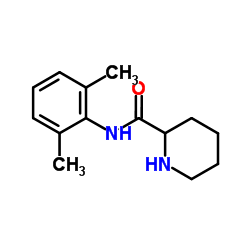N-(2,6-Dimethylphenl)-2-Piperidine Carboxamide

N-(2,6-Dimethylphenl)-2-Piperidine Carboxamide structure
|
Common Name | N-(2,6-Dimethylphenl)-2-Piperidine Carboxamide | ||
|---|---|---|---|---|
| CAS Number | 15883-20-2 | Molecular Weight | 232.321 | |
| Density | 1.1±0.1 g/cm3 | Boiling Point | 392.3±42.0 °C at 760 mmHg | |
| Molecular Formula | C14H20N2O | Melting Point | 114-117ºC | |
| MSDS | Chinese USA | Flash Point | 149.0±28.0 °C | |
| Symbol |

GHS06 |
Signal Word | Danger | |
|
Kinetics of bupivacaine after clonidine pretreatment in mice.
Can. J. Anaesth. 42(5 Pt 1) , 434-7, (1995) Previous studies have reported that clonidine pretreatment causes an increase in the local anaesthetic activity of bupivacaine. This study was designed to document possible changes in the pharmacokinetic behaviour of bupivacaine and its main metabolite, desbu... |
|
|
Population pharmacokinetic analysis of ropivacaine and its metabolite 2',6'-pipecoloxylidide from pooled data in neonates, infants, and children.
Br. J. Anaesth. 107(3) , 409-24, (2011) The aim was to characterize ropivacaine and 2',6'-pipecoloxylidide (PPX) pharmacokinetics and factors affecting them in paediatric anaesthesia.Population pharmacokinetics of ropivacaine and its active metabolite PPX were estimated after single and continuous ... |
|
|
Bupivacaine kinetics during hyperthermia in rats.
Can. J. Anaesth. 41(3) , 253-6, (1994) The aim of this study was to document possible alterations of bupivacaine pharmacokinetic behaviour in rats during hyperthermia. Two groups of Wistar AF IO PS male rats (Group A = normothermic controls, Group B = hyperthermia-induced animals) received a singl... |
|
|
Determination of bupivacaine and metabolites in rat urine using capillary electrophoresis with mass spectrometric detection.
Electrophoresis 24(14) , 2340-7, (2003) A method using capillary electrophoresis-mass spectrometry (CE-MS) was developed for the structural elucidation of bupivacaine and metabolites in rat urine. Prior to CE-MS analysis, solid-phase extraction (SPE) was used for sample cleanup and preconcentration... |
|
|
Lack of metabolic racemisation of ropivacaine, determined by liquid chromatography using a chiral AGP column.
Chirality 7(4) , 272-7, (1995) Ropivacaine hydrochloride monohydrate (ropivacaine) is a new local anaesthetic agent which is administered exclusively as the (-)-(S)-form. The aim of the study was to determine whether metabolic racemisation of (-)-(S)-ropivacaine occurs. This was tested in ... |
|
|
Determination of bupivacaine and three of its metabolites in rat urine by capillary electrophoresis.
Electrophoresis 19(16-17) , 2997-3002, (1998) A capillary electrophoretic (CE) method for the analysis of urinary extracts of the local anesthetic, bupivacaine, and its three main metabolites, desbutylbupivacaine, 3'-hydroxybupivacaine, and 4'-hydroxybupivacaine, in rat urine has been developed. The limi... |
|
|
Effects of premedication medicines on the formation of the CYP3A4-dependent metabolite of ropivacaine, 2', 6'-Pipecoloxylidide, on human liver microsomes in vitro.
Basic Clin Pharmacol Toxicol. 98(2) , 181-3, (2006) Ropivacaine is a relatively new amide-type local anaesthetic, mainly used for surgery and postoperative pain relief. In this study we have investigated the interaction between the CYP3A4 metabolite of ropivacaine, 2',6'-pipecoloxylidide (PPX), and premedicati... |
|
|
Acute toxicity of bupivacaine metabolites in mice.
Clin. Exp. Pharmacol. Physiol. 21(12) , 997-9, (1994) 1. This study was designed to document the acute toxicity of two metabolites of bupivacaine, desbutylbupivacaine (2,6, desbutylbupivacaine; PPX) and pipecolic acid in mice. All the compounds were administered by the intraperitoneal (i.p.) route. 2. The mean c... |
|
|
Effects of tobacco smoke exposure on the kinetics of bupivacaine in mice.
Life Sci. 60(10) , 725-34, (1997) The aim of this work was to determine the effects of different time of tobacco smoke exposure on pharmacokinetics of bupivacaine in mice. Mice were exposed to tobacco smoke during 4 days (group T4) or 8 days (group T8) using the Hamburg II smoking machine. Co... |
|
|
Kinetics of bupivacaine after levcromakalim treatment in mice.
J. Pharm. Pharmacol. 49(3) , 293-5, (1997) Previous workers have reported that 0.01 mg kg-1 of levcromakalim injected intraperitoneally did not modify bupivacaine-induced neurotoxicity but increased the duration of action of bupivacaine. This study was designed to document possible changes in the phar... |